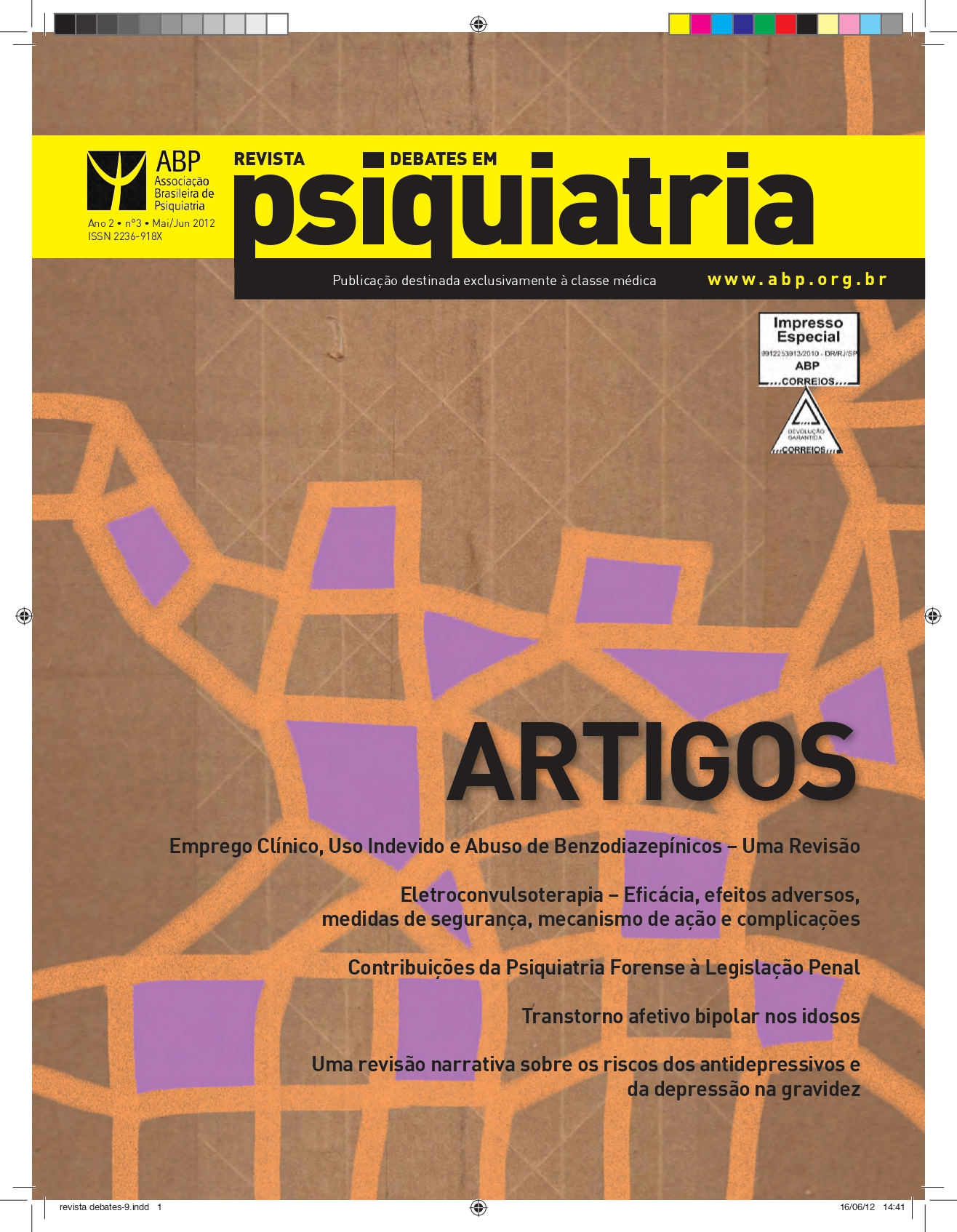Transtorno afetivo bipolar nos idosos
DOI:
https://doi.org/10.25118/2763-9037.2012.v2.885Palavras-chave:
transtorno bipolar, idosos, epidemiologia, tratamentoResumo
Introdução: O transtorno bipolar apresenta um grande impacto na vida social, econômica e afetiva na vida do paciente. Embora, a população esteja envelhecendo muito rapidamente, poucos são os estudos que investigam as características específicas desse transtorno nessa faixa etária. Objetivo: O objetivo desse estudo é realizar uma revisão das características do transtorno bipolar no idoso. Resultados: O transtorno bipolar no idoso apresenta características específicas diferente do transtorno bipolar no adulto em diversos tópicos como: a epidemiologia, os aspectos clínico/diagnósticos, as principais comorbidades e o tratamento. Conclusão: É necessário reconhecer o transtorno bipolar no idoso de maneira adequada a fim de o diagnóstico e o tratamento sejam feitos corretamente.
Downloads
Métricas
Referências
• 1. Berrios GE. The History of Mental Symptoms. New York, Cambridge University Press, 1996. DOI: https://doi.org/10.1017/CBO9780511526725
• 2. Cade JF. Lithium salts in the treatment of psychotic excitement. Med J Aust. 1942; 2: 349-52. DOI: https://doi.org/10.5694/j.1326-5377.1949.tb36912.x
• 3. Weissman MM, Leaf PJ, Tischler GL et al. Affective disorders in five United States communities. Psychol Med. 1988; 18: 141–53 DOI: https://doi.org/10.1017/S0033291700001975
• 4. Leboyer M, Henry C, Paillere-Martinot ML et al. Age at onset in bipolar affective disorders: a review. Bipolar Disord. 2005; 7: 111–8. DOI: https://doi.org/10.1111/j.1399-5618.2005.00181.x
• 5. Charney DS, Reynolds CF 3rd, Lewis L, et al. Depression and Bipolar Support Alliance consensus statement on the unmet needs in diagnosis and treatmentof mood disorders in late life. Arch Gen Psychiatry, 2003; 60: 664-672. DOI: https://doi.org/10.1001/archpsyc.60.7.664
• 6. Hirschfeld RM, Calabrese JR, Weissman MM et al. Screening for bipolar disorder in the community. J Clin Psychiatry. 2003; 64: 53–9. DOI: https://doi.org/10.4088/JCP.v64n0111
• 7. Kessler RC, Berglund P, Demler O, et al. Lifetime prevalence and age-of-onset distributions of DSM-IV disorders in the National Comorbidity Survey Replication. Arch Gen Psychiatry. 2005; 62: 593–602. DOI: https://doi.org/10.1001/archpsyc.62.6.593
• 8. Deep CA, Jeste DV. Bipolar disorder in older adults: a critical review. Bipolar Disord, 2004; 6: 343-367. DOI: https://doi.org/10.1111/j.1399-5618.2004.00139.x
• 9. Sajatovic M, Blow FC, Ignácio RV, et al. Age-related modifiers of clinical presentation and health service use among veterans with bipolar disorder. Psychiatr Serv, 2004; 55: 1014-1021. DOI: https://doi.org/10.1176/appi.ps.55.9.1014
• 10. Depp CA, Lindamer LA, Folsom DP, et al. Differences in clinical features and mental health service use in bipolar disorder across the lifespan. AM J Geriatr Psychiatry, 2005; 13: 290-298. DOI: https://doi.org/10.1097/00019442-200504000-00004
• 11. Yassa R, Nair NP, Iskandar H. Late-onset bipolar disorder. Psychiatr Clin North Am, 1988; 11:117-131. DOI: https://doi.org/10.1016/S0193-953X(18)30520-3
• 12. Goodwin FR, Jamison K. Manic-depressive Illness: Bipolar Disorders and Recurrent Depression, 2nd Edition. New York, Oxford University Press, 2007.
• 13. Brooks JO 3rd, Hoblyn JC, Kraemer HC, et al. Factors associated with psychiatric hospitalization of individuals diagnosed with dementia and comorbid bipolar disord. J Geriatr Psychiatr Neurol, 2006; 19: 72-77. DOI: https://doi.org/10.1177/0891988706286215
• 14. Ahearn EP, Steffens DC, Cassidy E, et al. Famiilial leukoencephalopathy in bipolar disorder. Am J Psychiatry, 1998; 155: 1605-1607. DOI: https://doi.org/10.1176/ajp.155.11.1605
• 15. Hays JC, Krishnan KR, George LK, et al. Age of onset of bipolar disorder: demographic, family, history and psychosocial correlates. Depress Anxiety, 1998; 7: 76-82. DOI: https://doi.org/10.1002/(SICI)1520-6394(1998)7:2<76::AID-DA5>3.0.CO;2-3
• 16. Krishnan KR. Biological risk factors in late life depression. Biol Psychiatry, 2002; 52: 185-192. DOI: https://doi.org/10.1016/S0006-3223(02)01349-5
• 17. Lantz MS, Buchalter EN. Pseudodementia: cognitive decline caused by untreated depression may be reversed with treatment. Geriatrics, 2001; 56: 42-43.
• 18. Brooks JO 3rd, Hoblyn JC. Secondary mania in older adults. Am J Psychiatry, 2005; 162: 2033-2038. DOI: https://doi.org/10.1176/appi.ajp.162.11.2033
• 19. Brooks JO, Hoblyn JC, Woodard S, et al. Relations between delayed memory and cerebral metabolism in older euthymic adults with bipolar disorder. Biol Psychiatry, 2007; 61:114.
• 20. Gildengers AG, Butters MA, Chisholm D, et al. Cognitive functioning and instrumental activities of daily living in late-life bipolar disorder. Am J Geriatr Psychiatry, 2007; 15:174-179. DOI: https://doi.org/10.1097/JGP.0b013e31802dd367
• 21. Shulman KI, Rochon P, Sykora K et al. - Changing prescription patterns for lithium and valproic acid in old age: shifting practice without evidence. BMJ. 2003; 326: 960–1 DOI: https://doi.org/10.1136/bmj.326.7396.960
• 22. Schaffer CB, Garvey MJ. Use of lithium in acutely manic elderly patients. Clin Gerontol. 1984; 3: 58–60.
• 23. Kessing LV, Sondergard L, Kvist K et al. Suicide risk in patients treated with lithium. Arch Gen Psychiatry. 2005; 62: 860–6 DOI: https://doi.org/10.1001/archpsyc.62.8.860
• 24. Kessing LV, Sondergard L, Forman JL et al. Lithium treatment and risk of dementia. Arch Gen Psychiatry. 2008; 65: 1331–5. DOI: https://doi.org/10.1001/archpsyc.65.11.1331
• 25. International Consensus Group on the evidence-based pharmacologic treatment of bipolar I and II depression. J Clin Psychiatry. 2008; 69:1632–46. DOI: https://doi.org/10.4088/JCP.v69n1014
• 26. Fountoulakis KN, Vieta E. Treatment of bipolar disorder: a systematic review of available data and clinical perspectives. Int J Neuropsychopharmacol. 2008; 11: 999–1029. DOI: https://doi.org/10.1017/S1461145708009231
• 27. Schaffer A, Mamdani M, Levitt A. et al. Effect of antidepressant use on admissions to hospital among elderly bipolar patients. Int J Geriatr Psychiatry. 2006; 21: 275–80. DOI: https://doi.org/10.1002/gps.1460
• 28. Aizenberg D, Olmer A, Barak Y. Suicide attempts amongst elderly bipolar patients. J Affect Disord. 2006; 91(1): 91–4. DOI: https://doi.org/10.1016/j.jad.2005.12.013
• 29. Sharma V, Yatham L, Haslam D. et al. Continuation and prophylactic treatment of bipolar disorder. Can J Psychiatry. 1997: 42: 92S–100S. DOI: https://doi.org/10.1016/S0006-3223(97)87290-3
• 30. Ghaemi S, Pardo T, Hsu D. Strategies for preventing the recurrence of bipolar disorder. J Clin Psychiatry. 2004; 65: 16–23.
• 31. Sajatovic M, Chen P. Geriatric bipolar disorder. Psychiatr Clin North Am. 2011; 34: 319-33. DOI: https://doi.org/10.1016/j.psc.2011.02.007
• 32. Schaffer CB, Garvey MJ. Use of lithium in acutely manic elderly patients. Clin Gerontol. 1984; 3: 58–60.
• 33. Cruz, LP, Miranda PM, Vedana KGC et al. Terapêutica medicamentosa: adesão, conhecimento e dificuldades de idosos com transtorno bipolar. Rev. Latino-Am. 2011; 19: 944-952. DOI: https://doi.org/10.1590/S0104-11692011000400013
Downloads
Publicado
Como Citar
Edição
Seção
Licença
Copyright (c) 2012 Alexandre Bastos Lima, Danielle Pessoa Lima, Carlos Clayton Torres Aguiar, Erico de Castro Costa

Este trabalho está licenciado sob uma licença Creative Commons Attribution-NonCommercial 4.0 International License.
Debates em Psiquiatria permite que o (s) autor (es) mantenha(m) seus direitos autorais sem restrições. Atribuição-NãoComercial 4.0 Internacional (CC BY-NC 4.0) - Debates em Psiquiatria é regida pela licença CC-BY-NC
































